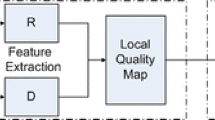Abstract
A variety of existing image quality assessment (IQA) metrics share a similar two-stage framework: at the first stage, a quality map is constructed by comparison between local regions of reference and distorted images; at the second stage, the spatial pooling is adopted to obtain overall quality score. In this work, we propose a novel spatial pooling strategy for image quality assessment through statistical analysis of the quality map. Our in-depth analysis indicates that the overall image quality is sensitive to the quality distribution. Based on the analysis, the quality histogram and statistical descriptors extracted from the quality map are used as input to the support vector regression to obtain the final objective quality score. Experimental results on three large public IQA databases have demonstrated that the proposed spatial pooling strategy can greatly improve the quality prediction performance of the original IQA metrics in terms of correlation with human subjective ratings.
Similar content being viewed by others
References
Lin W, Jay Kuo C C. Perceptual visual quality metrics: A survey. Journal of Visual Communication and Image Representation, 2011, 22(4): 297–312.
Daly S J. Visible differences predictor: An algorithm for the assessment of image fidelity. In Proc. SPIE/IS&T 1992 Symposium on Electronic Imaging: Science and Technology, May 1992, pp.2-15.
Lubin J. A human vision system model for objective picture quality measurements. In Proc. the 1997 International Broadcasting Convention, Sept. 1997, pp.498-503.
Wang Z, Bovik A C, Sheikh H R, Simoncelli E P. Image quality assessment: From error visibility to structural similarity. IEEE Transactions on Image Processing, 2004, 13(4): 600–612.
Sheikh H R, Bovik A C, de Veciana G. An information fidelity criterion for image quality assessment using natural scene statistics. IEEE Transactions on Image Processing, 2005, 14(12): 2117–2128.
Sheikh H R, Bovik A C. Image information and visual quality. IEEE Transactions on Image Processing, 2006, 15(2): 430–444.
Larson E C, Chandler D M. Most apparent distortion: Fullreference image quality assessment and the role of strategy. Journal of Electronic Imaging, 2010, 19(1): 011006.
Zhang L, Zhang D, Xuanqin M. FSIM: A feature similarity index for image quality assessment. IEEE Transactions on Image Processing, 2011, 20(8): 2378–2386.
Xue W, Zhang L, Mou X, Bovik A C. Gradient magnitude similarity deviation: A highly efficient perceptual image quality index. IEEE Transactions on Image Processing, 2014, 23(2): 684–695.
Wang Z. Applications of objective image quality assessment methods [applications corner]. IEEE Signal Processing Magazine, 2011, 28(6): 137–142.
Bovik A C. Automatic prediction of perceptual image and video quality. Proceedings of the IEEE, 2013, 101(9): 2008–2024.
Wang Z, Li Q. Information content weighting for perceptual image quality assessment. IEEE Transactions on Image Processing, 2011, 20(5): 1185–1198.
Shnayderman A, Gusev A, Eskicioglu A M. An SVD-based grayscale image quality measure for local and global assessment. IEEE Transactions on Image Processing, 2006, 15(2): 422–429.
Seshadrinathan K, Bovik A C. Motion tuned spatiotemporal quality assessment of natural videos. IEEE Transactions on Image Processing, 2010, 19(2): 335–350.
Moorthy A K, Bovik A C. Visual importance pooling for image quality assessment. IEEE Journal of Selected Topics in Signal Processing, 2009, 3(2): 193–201.
Wang Z, Shang X. Spatial pooling strategies for perceptual image quality assessment. In Proc. the 2006 IEEE International Conference on Image Processing, Oct. 2006, pp. 2945–2948.
Engelke U, Kaprykowsky H, Zepernick H, Ndjiki-Nya P. Visual attention in quality assessment. IEEE Signal Processing Magazine, 2011, 28(6): 50–59.
Gong M, Pedersen M. Spatial pooling for measuring color printing quality attributes. Journal of Visual Communication and Image Representation, 2012, 23(5): 685–696.
Schlkopf B, Smola A J. Learning with Kernels: Support Vector Machines, Regularization, Optimization, and Beyond. MIT Press, 2002.
Sheikh H R, Wang Z, Cormack L, Bovik A C. LIVE image quality assessment database release 2, 2005. http://live.ece.utexas.edu/research/quality/, Feb. 2016.
Larson E C, Chandler D. Categorical image quality (CSIQ) database, 2010. http://vision.okstate.edu/csiq, Feb. 2016.
Ponomarenko N, Lukin V, Zelensky A, Egiazarian K, Carli M, Battisti F. TID2008 — a database for evaluation of full-reference visual quality assessment metrics. Advances of Modern Radioelectronics, 2009, 10(4): 30–45.
Rohaly A M, Libert J, Corriveau P, Webster A et al. Final report from the video quality experts group on the validation of objective models of video quality assessment. ITU-T Standards Contribution COM, 2000, 1: 9–80.
Chandler D M, Hemami S S. VSNR: A wavelet-based visual signal-to-noise ratio for natural images. IEEE Transactions on Image Processing, 2007, 16(9): 2284–2298.
Author information
Authors and Affiliations
Corresponding author
Additional information
Special Section on Video Coding and Assessment
This work was supported by the National Natural Science Foundation of China under Grant No. 61571212 and the Natural Science Foundation of Jiangxi Province of China under Grant No. 20151BDH80003.
Rights and permissions
About this article
Cite this article
Li, Q., Fang, YM. & Xu, JT. A Novel Spatial Pooling Strategy for Image Quality Assessment. J. Comput. Sci. Technol. 31, 225–234 (2016). https://doi.org/10.1007/s11390-016-1623-9
Received:
Revised:
Published:
Issue Date:
DOI: https://doi.org/10.1007/s11390-016-1623-9




